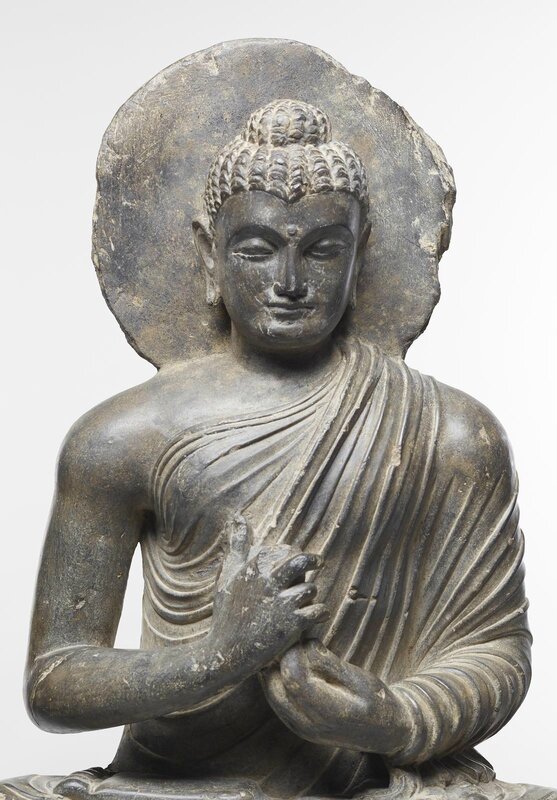A schist figure of Buddha, Ancient region of Gandhara, 3rd-4th century
Lot 63. A schist figure of Buddha, Ancient region of Gandhara, 3rd-4th century. Estimate US$ 150,000 - 250,000 (€140,000 - 230,000). Photo: Bonhams.
Enthroned and nimbate, wearing a sumptuous robe over his athletic body, Buddha displays the gesture of teaching and gazes steadfast. 30 1/2 in. (77.5 cm) high
Notes: Few examples convey so well the varying density of Buddha's robe as it courses, drapes, wraps, and pools over his body. His left forearm is covered with layer upon layer of thick, rounded folds, while his right pectoral is bound within a thin section spreading from underneath his heavy collar. The sumptuous curvilinear folds combine with his strong hands and finely modeled right triceps to evoke the muscular body underneath, in an otherwise sedate posture.
The true testament to the sculptor's mastery is seen in the panoply of folds falling over the cushioned plinth. Although not usually modeled with as much attention and variety, their inclusion seems almost ubiquitous throughout depictions of Preaching Buddha. The folds are seen on a similar cushioned throne, supported by leonine throne-legs that flank an analogous scene of devotees offering bouquets to the Buddha, under a closely related example published in Ingholt, Gandharan art in Pakistan, New York, 1957, no. 248. Also see Zwalf, Gandharan Sculpture, Vol. II, p. 23, nos. 25, and 26.
With his hands in the gesture of teaching dharmachakrapravartana mudra, the iconography is thought to refer to setting the 'Wheel of Law' in motion and the Buddha's first sermon delivered near the holy city of Varanasi, at Deer Park in Sarnath. There the Buddha is said to have propounded his new doctrine and established the institution of Buddhism.
Given its size, the figure more likely stood alone as a self-contained image in its original context, but depictions of Buddha in dharmachakrapavartina mudra also appear at the center of much larger compositions thought to represent either his performance of miracles at Sravasti or scenes of his residence in paradise (see Behrendt, The Art of Gandhara, New York, 2007, p. 67-8, fig. 29).
Exhibited: Buddha zwischen Ost und West: Skulpturen Aus Gandhara/Pakistan, Museum Rietberg, Zurich, 1987.
Published: Rene Russek, Buddha zwischen Ost und West: Skulpturen Aus Gandhara/Pakistan, Ausstellungskatalog, Museum Rietberg, Zurich, 1987, p. 64, no. 65.
Provenance: Dr. J.R. Belmont Collection, Basel, acquired 1976
Private Swiss Collection
Sotheby's, New York, 18 March 2009, lot 36
Private American Collection
Bonham's. INDIAN, HIMALAYAN & SOUTHEAST ASIAN ART, 16:00 EDT - NEW YORK

/https%3A%2F%2Fprofilepics.canalblog.com%2Fprofilepics%2F1%2F0%2F100183.jpg)
/https%3A%2F%2Fstorage.canalblog.com%2F03%2F02%2F119589%2F96711876_o.jpg)
/https%3A%2F%2Fstorage.canalblog.com%2F11%2F31%2F119589%2F94773502_o.jpg)
/https%3A%2F%2Fstorage.canalblog.com%2F20%2F83%2F119589%2F94772815_o.jpg)
/https%3A%2F%2Fstorage.canalblog.com%2F26%2F72%2F119589%2F75604929_o.jpg)
/https%3A%2F%2Fstorage.canalblog.com%2F59%2F60%2F119589%2F26458628_o.jpg)




/image%2F1371349%2F20240417%2Fob_9708e8_telechargement.jpg)
/image%2F1371349%2F20240412%2Fob_032fb1_2024-nyr-22642-0928-000-a-rare-painted.jpg)
/http%3A%2F%2Fstorage.canalblog.com%2F37%2F38%2F119589%2F129773469_o.jpg)
/http%3A%2F%2Fstorage.canalblog.com%2F50%2F43%2F119589%2F129706599_o.jpg)